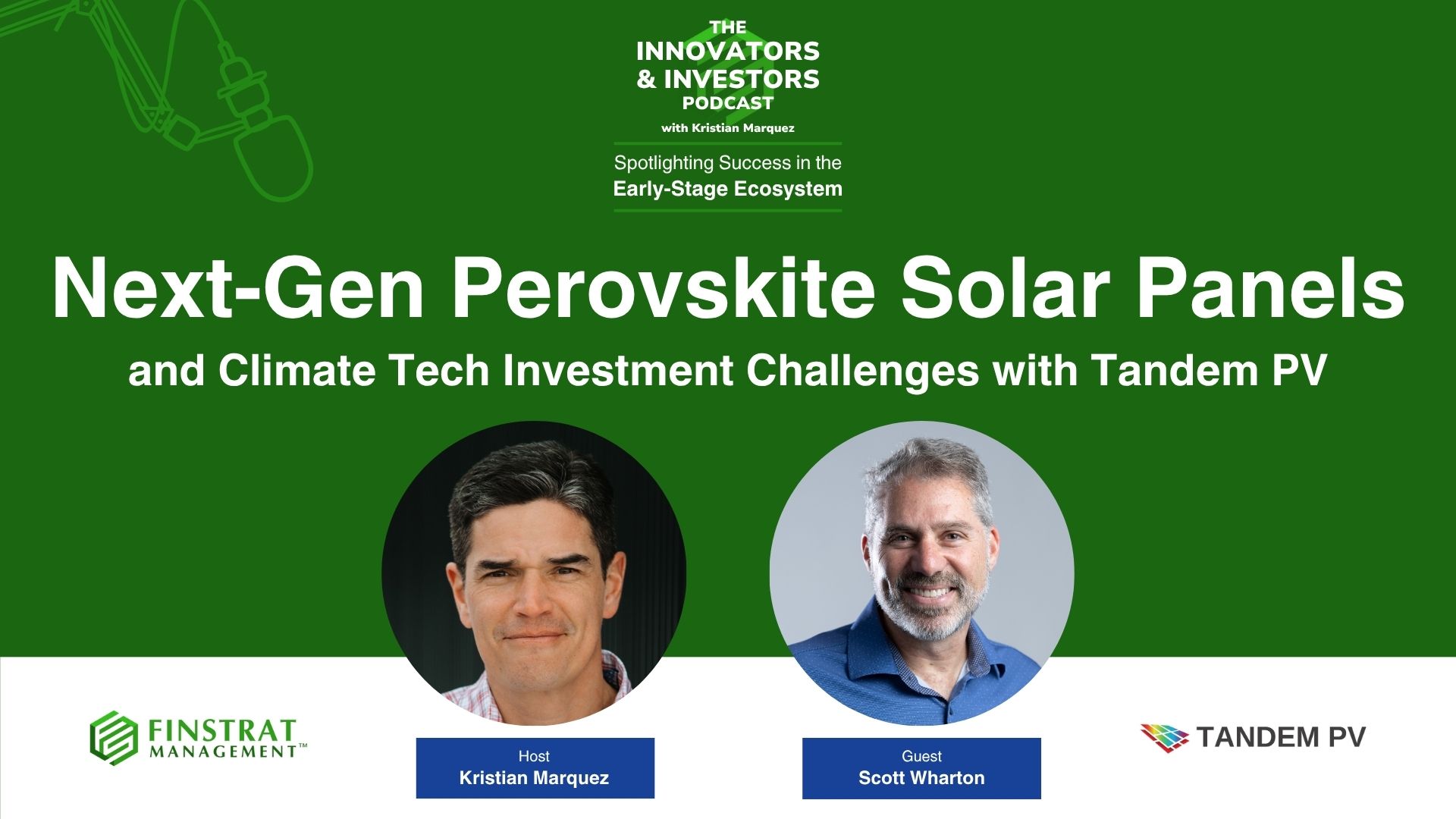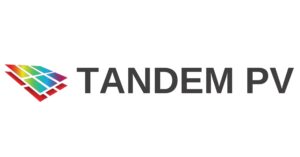Next-Gen Perovskite Solar Panels and Climate Tech Investment Challenges with Tandem PV
August 6, 2025 | 46 MIN

Highlights
- Tandem PV is developing advanced perovskite-silicon tandem solar panels that are 30% more efficient and cheaper than traditional silicon panels.
- Tandem is committed to U.S.-based manufacturing to reduce reliance on China’s solar supply chain and enhance energy security.
- Perovskite technology is a game-changer due to its thinness, low energy input for manufacturing, and potential efficiency improvements up to 45%.
- Scaling deep tech climate innovations faces a critical funding gap known as the “missing middle” or “valley of death.”
- Scott’s personal journey includes leading internet startups, a global sabbatical with family, and a leadership role at Logitech before returning to renewable energy.
- Innovation thrives when interdisciplinary teams co-locate, enabling organic, serendipitous problem-solving beyond scheduled meetings.
- The episode underscores the tension between taking entrepreneurial risks and the comfort of conventional career paths, emphasizing growth through challenge.
Summary
In this wide-ranging episode of the Innovators and Investors Podcast, host Kristian Marquez interviews Scott Wharton, CEO of Tandem PV, a company pioneering next-generation solar panel technology. Tandem PV’s innovation centers on perovskite-based solar panels, which are lighter, thinner, more efficient, and cheaper than traditional silicon panels. Scott explains how Tandem addresses two critical challenges: meeting the soaring energy demands driven by AI and reducing U.S. dependence on solar manufacturing dominated by China. The company’s tandem solar panels combine a perovskite layer atop a silicon base, achieving 28% efficiency today with a theoretical ceiling around 45%, far surpassing traditional silicon limits.
Scott details how Tandem is transitioning from late-stage R&D to commercial manufacturing, targeting U.S.-based production to leverage local talent and security advantages despite higher costs. He also highlights the systemic challenges in scaling climate technologies, specifically the funding gap known as the “missing middle” or “valley of death,” where early-stage grants exist but scaling capital is scarce due to risk aversion. He advocates for innovative financing models involving diversified, pooled investments from government, nonprofits, and private actors to bridge this gap.
The conversation also delves into Scott’s personal journey, from his MBA at Yale and early career in internet startups to a sabbatical backpacking around the world with his family, followed by leadership roles at Logitech and ultimately his return to solar energy. Scott shares leadership insights about the importance of working with human nature, embracing risk, and the value of co-locating teams to foster innovation. He stresses that while comfort is appealing, pushing beyond it drives growth and opportunity. He closes by acknowledging mentors and supporters who gave him chances when he was an unconventional candidate.
Overall, the episode offers a deep look into cutting-edge solar technology, geopolitical and economic dynamics of energy manufacturing, the challenges of scaling deep tech climate solutions, and valuable personal and professional lessons from a seasoned entrepreneur.
Key Insights
- Perovskite-Silicon Tandem Panels Represent a Major Leap in Solar Efficiency: Combining perovskite with silicon layers allows Tandem to surpass the physical efficiency limits of traditional silicon panels. This layered approach captures more of the solar spectrum, boosting conversion efficiency from about 21% (silicon alone) to 28% currently, with potential to reach 45%. This breakthrough not only improves power density but also reduces the footprint and overall costs of solar farms, making solar a more viable and scalable energy source for utility-scale applications, especially essential given rising AI power demands.
- Onshoring Solar Manufacturing is Both a Strategic and Security Imperative: With China dominating 95% of silicon solar cell manufacturing, U.S. dependence on foreign supply chains poses risks amid geopolitical tensions. Tandem’s push for American-made solar panels aligns with bipartisan recognition that energy independence is crucial. However, manufacturing in the U.S. faces challenges such as higher labor and energy costs and less state-sponsored capital compared to China’s subsidized ecosystem. Tandem’s approach to co-locate R&D and manufacturing in California leverages local talent and innovation speed over cost, aiming to establish a competitive U.S.-based foothold in advanced solar tech.
- The “Missing Middle” Funding Gap Threatens Climate Tech Scale-Up: Early-stage R&D often benefits from government grants and seed funding, while billion-dollar companies have access to loans and capital markets. However, scaling from prototype to factory—especially for physical, hardware-heavy climate technologies—faces a severe funding gap due to risk aversion among venture capitalists and financiers. Scott describes a patchwork approach involving venture debt, catalytic capital, and charitable funding to bridge this “valley of death.” He proposes innovative crowd-funded, diversified risk pools combining public and private capital to democratize investment and reduce risk barriers in climate tech scale-up.
- Interdisciplinary Teams and Proximity Drive Innovation in Deep Tech: Scott emphasizes that breakthroughs in perovskite technology require expertise across material science, physics, chemistry, and metallurgy. Beyond technical skills, proximity matters—co-locating R&D and manufacturing teams enables spontaneous, organic collaboration, accelerating problem-solving and innovation. This philosophy echoes lessons from manufacturing pioneers like Elon Musk who advocate for reducing middle management layers and fostering “player-coach” roles, empowering skilled teams to move fast and adapt continuously.
- Entrepreneurial Success is Rooted in Understanding Human Nature and Risk Tolerance: Scott highlights the importance of recognizing different adopter types—early, middle, late—and tailoring engagement accordingly. Success requires balancing risk-seeking and risk-averse mindsets and finding the right “tribe” to drive adoption. He also reflects on personal growth, noting that risk-taking often decreases with age due to increased responsibilities, but taking deliberate sabbaticals can refresh perspectives and fuel renewed drive. This insight is vital for entrepreneurs managing career transitions and scaling ventures.
- Taking Sabbaticals Can Reframe Identity and Enhance Leadership: Scott’s year-and-a-half global journey with his family provided deep personal insights—improving family bonds, building independence in his children, and challenging his identity beyond professional roles. He emphasizes that stepping away from work to focus on personal development can be humbling and enriching, offering lessons in humility, patience, and the human side of leadership often overshadowed by career ambitions. This approach contrasts with the relentless startup grind and suggests a balanced, sustainable path for long-term impact.
- The Chinese Solar Manufacturing Model is Difficult to Compete With but Not Insurmountable: China’s solar dominance stems from state-backed unlimited funding, low electricity costs, and practices such as subsidized labor and land, sometimes bordering on unfair trade. This creates a challenging environment for free-market competitors. However, Tandem’s focus on a fundamentally new technology and building advanced manufacturing capabilities in the U.S. offers a chance to break the cycle by leapfrogging legacy silicon tech, establishing a new industrial standard that is less dependent on current supply chain vulnerabilities.
- Mentorship and Risk-Taking Opportunities are Critical for Career Growth: Scott shares how key mentors opened doors for him despite unconventional backgrounds, underscoring the importance of champions who see potential beyond credentials. He advises younger professionals to focus on doing what they love, are good at, and what provides value, rather than worrying excessively about outcomes. This mindset, combined with courage to take risks early in one’s career, forms the foundation for long-term success and fulfillment.
Conclusion
This episode offers a comprehensive exploration of the future of solar energy through the lens of Tandem PV’s breakthrough technology and the entrepreneurial journey of its CEO, Scott Wharton. It balances technical innovation with strategic, economic, and human factors shaping the renewable energy landscape. The discussion also provides practical insights on overcoming systemic funding challenges in climate tech and highlights the value of risk-taking, interdisciplinary collaboration, and personal growth in driving meaningful impact.
Stay up-to-date with Scott Wharton and his work with Tandem PV.
Follow the show on your podcast channel of choice or listen below.




